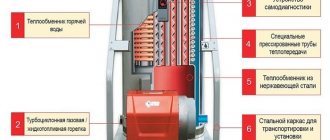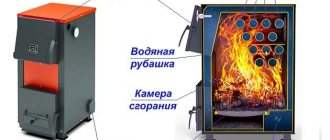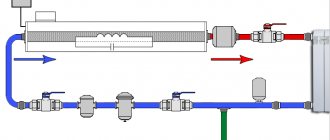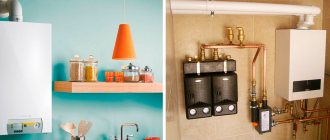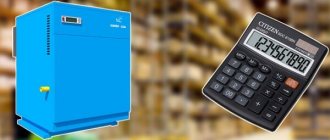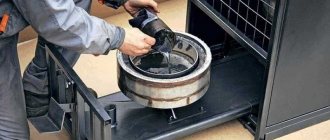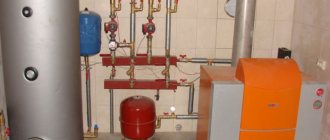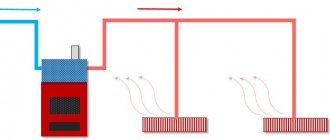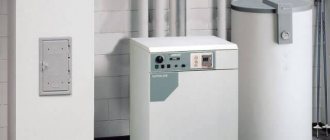Advantages and disadvantages of installing VIN
As mentioned earlier, induction boilers, compared to their predecessors, heating elements, are characterized by greater efficiency. The monetary costs of heating with induction heaters are not only lower than when using heating elements, but also do not change during operation. An automatic control system controls the air temperature in the room and, if necessary, turns off the heater, so the boiler operating time per day is no more than 8 hours. The efficiency of tubular heaters subsequently decreases significantly and increases the cost of electricity.
Economics of VIN use
VINs belong to electrical safety class 2 devices, having reinforced insulation. An induction boiler does not require grounding or additional ventilation in the room. Fire safety is ensured by the absence of connecting sections and electrical contacts exposed to high temperatures.
Not only water can act as a coolant, but also any liquid non-freezing materials that do not need to be removed from the system with the onset of cold weather. This is true for rooms not used during such a period - the boiler can simply be turned off. No additional technological preparation of the carrier is required. In addition, even when using “hard” technical water, there is no problem of scale, since magnesium and calcium ions, due to the influence of powerful eddy currents, do not settle on the walls of the pipe, but are removed with a stream of hot water.
To install a VIN, no special approvals are required from regulatory authorities (Rospotrebnadzor), unlike gas heaters. The design can be easily integrated into an existing heating system.
The main disadvantage of induction boilers is their high cost. Their use is also impossible in open heating systems. It is also not always possible to mount the heater on a wall.
Unlike a heating element, an induction boiler will last for 30, and when used in a residential area - 40 years, or more than 100,000 hours. The equipment does not require inter-seasonal checks, preventive maintenance is kept to a minimum. When carrying out work on installing boilers, there is also no need to involve qualified workers. In addition, induction boilers are silent during operation.
Durability, compactness, autonomy and the absence of the need for frequent maintenance make VIN a profitable alternative to uneconomical tubular heaters and gas boilers that require high initial costs.
Vortex Induction Heater
Due to its economic benefits, induction heating is widely used today. The vortex induction heating device is perfect for rooms up to 60 square meters. m, which must be heated with electricity. Thus, VIN can be used for heating private houses, industrial and warehouse premises, gas stations, car service centers and other free-standing facilities.
The main advantages of using VIN as the “heart” of the heating system include the following:
- Heating occurs almost instantly, because heat occurs directly in the part;
- Over the years, the installation operates with the same power, its productivity does not decrease;
- Compared with conventional electric heating elements, the induction vortex device saves up to 50% of electricity.
That is why today, more and more companies producing household appliances and production machines are using induction heating. An example of such use, in addition to heating boilers, is an induction electric furnace. Ultrasonic induction heater is used in the food industry. For heating metals in industry, an inverter induction apparatus is used, for melting non-ferrous metals - a melting-reduction unit, forging iron and making blanks - an induction electric forge.
Heat pumps vary in power, design and efficiency. Read more about this in the following article:
Equipment options
Almost all manufacturers offer induction boilers in the power range from 3 to 80 kW in two types of configurations:
- standard. Includes equipment for controlling the boiler (cabinet measuring 20x40 cm and a remote control that allows contactless control) and a temperature sensor.
- improved (VIP). In addition to the standard set, it contains a coolant flow sensor, a circulation pump and shut-off and control valves. The kit includes a boiler safety group - structural elements that protect against excess pressure in the system. Most often this is a system of a pressure gauge, a valve for releasing excess coolant and an air vent.
Specifications
The induction boiler is universal and connects to a regular 220 V electrical network supplying alternating current (frequency 50 Hz). There are models operating from a 380 V network.
Thermal performance depends on the power of the heater and varies from 2500 to 67400 Kcal/hour for various configurations. An increase in power, and, consequently, the potential size of the heated room, affects the price of the VIN. Boilers with a power of over 7 kW are a system of three heaters arranged in series.
Dimensions for single heaters (VIN-3, -5, -7/220 V) are most often indicated as structure height x diameter. A typical boiler with a diameter of 13.3 cm has a height of about 62 cm. The weight of the device is 25-30 kg. More powerful boilers can weigh up to 185 kg, which imposes certain restrictions on their wall placement.
The diameter of the inlet and outlet pipes is the same and, depending on the characteristics of the VIN and the manufacturer, is 23-32 mm.
DIY induction heating boiler
At home, the heater can be made from a welding inverter or transformer.
Boiler made from a welding inverter
Before proceeding directly to assembly, you need to stock up on the following materials:
- Stainless steel wire with a diameter of 5-7 mm;
- A piece of plastic heat-resistant pipe, approximately 500 mm long, with an outer diameter of no more than 50 mm and a wall thickness of at least 5 mm;
- Expanded or woven stainless steel mesh with a window no larger than 4x4 mm. The size of the mesh should completely cover the cross-section of the plastic pipe and provide the possibility of reliable fastening;
- Enameled copper wire with a diameter of 1.2-1.5 mm. To wind the coil you will need approximately 5m;
- Two adapters for connecting the boiler to the heating main;
- Welding inverter, allowing smooth adjustment of current strength.
Once all the necessary components are prepared, you can begin to assemble the induction boiler. Assembly consists of several stages:
1. Stainless steel wire is cut into pieces 5-6 cm long in the amount necessary to completely fill the pipe.
2. One side of the pipe is covered with a mesh, after which the wire sections are filled in and the other side is sealed. The internal cavity of the pipe is completely filled, and the presence of a fencing mesh on both sides prevents pieces of wire from getting into the pipelines of the heating system.
3. 90-100 turns of copper wire are wound onto the filled pipe. During the winding process, it is necessary to ensure uniformity and the same distance between the turns. The entire coil should be equidistant from both ends of the pipe.
4. Adapters are hermetically installed at the ends of the pipe, and a tie-in is made into the existing heating main.
5. Both coil terminals are connected to the welding inverter.
6. The heating circuit installed in this way is filled with coolant, after which the system is ready for operation.
It is strictly prohibited to connect the device to the electrical network until the system is completely filled with coolant.
7. Using the inverter, the required temperature regime is set.
This DIY induction device design can effectively heat an area of 50–60 m2. If the heated area is larger, or additional power is required for autonomous hot water supply, there is a second option.
Induction boiler using a transformer
When using a transformer, the role of the heating element is played by the body of the device, inside which the coolant circulates. To manufacture the unit, in addition to welding skills, you will need:
- Two metal pipes placed one inside the other in such a way that a cavity is formed between them.
- Two flat rings for sealing ends;
- Welding inverter;
- Three-phase transformer;
- Metal pipes for inlet and outlet pipes.
1. At some distance from the ends, pipes are welded into the hollow cylinder to ensure coolant circulation.
2. By winding copper wire around the body, the primary winding is formed;
3. To slow down cooling and reduce the dissipation of thermal energy, the product is placed in a special housing, and the resulting cavity is filled with heat-resistant heat-insulating material.
Security
To prevent accidents, when installing homemade induction boilers intended for heating a private home, you must adhere to several rules:
- When connecting the product to the heating system, the distance from the wall must be at least 30 cm, and from the floor and ceiling at least 80 cm;
- Devices can only be installed in closed circuits with forced coolant circulation;
- A pressure gauge and a safety valve should be installed on the outlet pipe.
The use of the phenomenon of electromagnetic induction in the manufacture of heating boilers makes it possible to significantly reduce the dimensions of products, ensure high productivity and long service life of the equipment.
Design and operation diagram of VIN
Induction boilers have a three-layer structure:
- an outer metal layer that protects the device from external influences;
- a thermal insulation layer that prevents overheating of the boiler;
- inner layer (core).
The core is the key element of the VIN. It is a metal pipe in the shape of a cylinder, toroidally wrapped with the wire of an induction coil (inductor). The pipe, otherwise called a heat exchange device, is made of ferrimagnetic material (steel). The winding is impregnated with a special composition, which allows the insulation of the structure to be classified as heat resistance class H (maximum temperature - 180°C).
VIN-10 vortex induction heater
Alternating current from the source enters the coil wires, generating an alternating magnetic field. Under the influence of a magnetic field, eddy induction currents arise in the electrically conductive substance (water, antifreeze) filling the heat exchanger pipe. This leads to heating of the material and release of thermal energy into the atmosphere. Heat loss in this process is about 1-2%, the boiler efficiency remains constant during operation (98%).
Thus, cold water, rising through the heat exchanger, quickly heats up due to electromagnetic induction and is supplied to the boiler outlet pipe already hot. The time spent on heating is several minutes. The winding temperature remains no higher than 140°C, which makes the induction boiler fireproof. The temperature difference between the metal surface of the heater and the coolant does not exceed 30°C.
Technical characteristics of VIN-10 The quality of coil insulation and pipe welds in the core is an important factor affecting the durability of the boiler. It is recommended to replace the coolant every 10 years. It is also recommended to purchase an uninterruptible power supply for the boiler in case of emergency situations.

